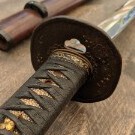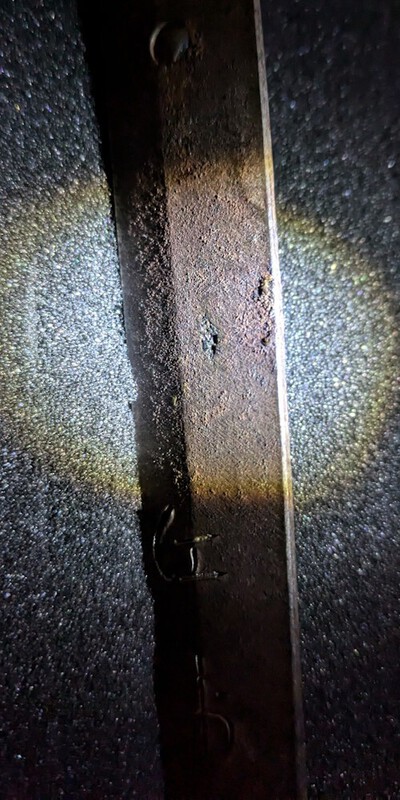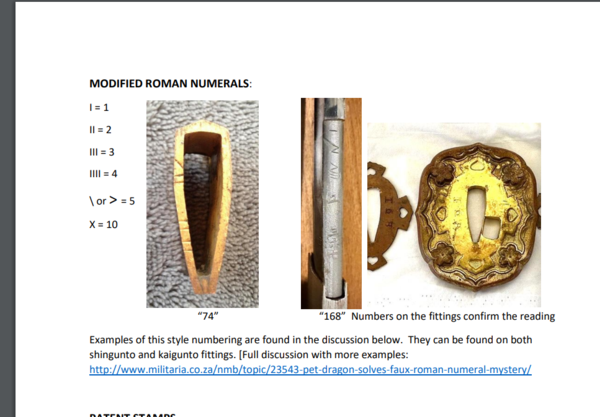-
Posts
228 -
Joined
-
Last visited
Everything posted by George KN
-
Hi guys, I woke up this morning and immediately knew how I could settle this - I have a pinpointer for metal detecting downstairs... Turns out I was wrong! The menuki are indeed metal, and I have learnt something yet again 😄 Thanks for helping correct my assumption and broadening my understanding of the materials they can be made of. Does anyone else have examples of humble koshirae they can show me so I can compare with my own?
-
Wooden menuki aren't a thing?! I always assumed they would be on cheaper fittings - along with another blade I bought at the same auction, this was the first sword I ever owned, so I guess I never thought anything about it until today Also, I think copper is unlikely, because there is no green patina at all, even though all the other fittings show considerable wear (I've found more natural lighting pics): And here are two pics from the auction with much better lighting (and the original mekugi which matches): Just based on sound alone, I can't discount ivory or bone - it definitely makes a more natural tapping sound, and the patina would make more sense... Still not sure how to test it one way or another though? That is genuinely awesome! Has to be a strong contender for the oldest nihonto fitting... I really do like the sentimentality/connection to the past that someone must have had to make use it.
-
Hi Dan, it is good to see someone else has some worn koshirae! A daisho too, wow. It would be great if possible to see some of the wood shavings if you can, as I've never seen that before. It definitely sounds like someone had hit hard times if they still needed the swords but couldn't afford a proper repair... If they couldn't afford a replacement I imagine it must have been in use a lot longer than most - imagine the things that daisho has seen!
-
Are wooden menuki uncommon?
-
@Franco D They certainly sound like wood when tapped, and look like wood in person (perhaps with a varnish of some kind on?) - admittedly the lighting isn't great in my previous pictures, so this is what it looks with natural light: And then some close ups (again with poor lighting): Is there a more definitive, non-destructive test I can take?
-
With time I've come to really appreciate the simple koshirae of my o-wakisashi. It has made me wonder whether a samurai was down on their luck and couldn't afford a better koshirae, or alternatively a lord trying to quickly equip an army with as many blades as possible. Does anyone else have any wooden menuki? I can't seem to find a single thread about them here? (The mekugi peg was originally the same colour and type of wood, but the auction lost it before it got to me 🤦♂️) Also feel free to share your own workhorse koshirae or fittings - I know they aren't what people usually collect, and I'd imagine samurai would have upgraded them if possible later, so it makes me wonder what other examples survive! Thanks, George
-
True, but so long as the government don't outright ban antique curved swords here again, we should be alright! All of my Nihonto have been from auctions because of the price issue, and while risky, it is quite easy to find low/mid grade swords and while it has got more expensive to ship nationwide, it is still doable with UPS or dedicated couriers. I think the major hurdle for newcomers (as has already been mentioned by others here) is information accessibility. Younger people lean more heavily on the internet rather than books, and this forum is basically the only large-scale website with detailed knowledge. As a hobby we probably need more outreach on YouTube, Reddit, Instagram etc and at the very least some more cheat sheets compiling some of the basics/mid level info.... If I had the time, one of these days I'd very much like to set up a simple website with that basic info (my job literally is building those things anyway). Might be a good way to actually force myself to learn more about the schools now that I think about it (Edit: shout-out to https://www.Japanese...ndex.com/nihonto.htm for also being an invaluable internet resource - it is exactly this kind of thing but with better mobile support and more images we need)
-
One day I think more of the anime crowd will realise that you can buy actual Nihonto for cheaper than some cosplay items, and then I think we'd see a whole lot more new (and likely younger) people... Hopefully then prices will increase too - you really shouldn't be able to buy these historic pieces cheaper than a second hand car...
-
25+ (coincidentally this is the only place on the internet where I regularly feel underqualified, and at times, downright stupid )
-
I'm a nihonto novice, but I'd say that's a nice wakizashi! Suriage, so likely a katana in the past, and nice to have even a little bit of the signature so you know it isn't mumei. The mei is also on the side to suggest it wasn't a tachi either, and from the patina it's clearly been this way for a while. I'm therefore taking a wild guess at saying a koto blade that was them shortened in the shinto period? Sadly I can't help with the translation. The tsuba looks good and old too. It looks like it was for a larger sword and has then been fitted to a smaller one - so I guess it is possible this tsuba was the same one pre/post suriage. It would be good to have another picture of the kissaki since I can't make out any details on the first once.
-
Thanks John - and I agree about the point about koto - it was more whether the koshirae is shinto or shinshinto?
-
Hi Dan, thanks for the reply! I sadly don't have the wakizashi in my possession just yet, so I can't remove the tsuka (it might be a few weeks knowing most auctions and couriers). Very much looking forward to finding out what it is hiding - although I at least can tell it is a genuine nihonto from the faint hamon shown in a few of the photos. And good eyes on the missing nodes - I actually have an o-wakizashi with this same problem (pardon the pun) too: Is it possible to get them repaired without having to have the tsuka rewrapped?
-
Thanks for the replies, always good learning more - and just for clarity I should add it wasn't the only thing wrong with the tanto: The ware just happened to be the final straw that made me think even if I did rewrap the tsuka and get the blade polished, it would still not be a great example. I am trying very hard to learn from past mistakes and not buy things with issues that need addressing... This is the one I did go for though:
-
So I was auction diving again, and found this wakizashi for sale with yet again no information. I won the lot, but haven't got it back from the auction yet (so unsure if mumei etc), but I've already got a few questions on the koshirae. I primarily bought it because it looks to me like it is well put together and fairly high decent quality - and of course because I like the dragon theme. I've also always wanted a Chrysanthemum tsuba after having read several threads here on them (like https://www.militaria.co.za/nmb/topic/47308-16-petal-chrysanthemum-tsuba/), so this was a win-win for me. My primary question is what age do people think the koshirae is? Shinto? And secondarily is there a name for the geometric pattern on the fuchi and fuchi-kashira? Any other thoughts good or bad are more than welcome - I've also never had a kogatana so I'm looking forward to having that in hand too (No pictures of the actual blade, so hoping it's actually there!) Thanks, George
-
I don't know much about mine, but I have often thought my gunbai tsuba could be early and made for war rather than art: It is only 8cm in diameter though, but feels very practical. I do wonder why you would need tsuba any larger than this, as extra weight feels like it would be a disadvantage, and I can't see much benefit of a wider tsuba if its primary purpose is to prevent an opponents weapon from sliding down your own and attacking your hand. So I also agree with the opinions that larger tsuba are likely for show rather than utility.
-
Thanks Jeremy - that's good to know - the splitting just seemed excessive for such a small blade, and I'm not sure whether it continued even further beyond the photo too. Out of curiosity, are ware immediately this bad after the smithing process, or is it something that gets worse with age and poor storage? And does the many wire-like ware in the first image indicate steel that has been folded more times than in the tanto?
-
I was once again auction diving for Nihonto, and came across two blades, both with ware on the mune. One of them I've actually bought (and will probs raise another thread about when I get my mitts on it), as it doesn't look too severe to me, the splits are very small and wire like, and generally I don't mind some flaws (the koshirae is also very nice). (Please correct me if you think this is a problem though): However, the second blade, what I think is a tanto (the auction described it as a wakizashi), is much more beaten up. Again, I don't mind tired blades, but after seeing the severity of the kizu I felt it was a lost cause: Am I right in thinking that about the tanto? Can a ware become so bad it is considered fatal?
-

On a scale of 0-10, how fake is this sword?
George KN replied to George KN's topic in Military Swords of Japan
Since receiving the sword, I think I've spent almost every evening doing at least some piece of work on the Emura, mostly trying to clean out the darned mould, and it became increasingly obvious that the black paint wasn't meant to be there, nor most of the other colours for that matter - it was applied really thickly to both the saya and the tsuka wrap, often with large drips, and covering other fittings. It was a real mess - and whilst cleaning the mould from everywhere I could, I realised the original gunto green was still under the fittings on the saya: So long story short (unless you guys want to see the stage by stage saya photos?), this is what she looks like now: I know it is not a perfect job, that some of the colours still aren't right, and it is still a battered piece that has been messed around with (not like many of the other awesome swords I see in the other threads!). However, it is obvious now that someone decided they didn't like the old rust damage (which is genuinely black with age) hence all the paint, but I know I much prefer the more honest look. I also learnt from the auction house that it came from a deceased estate, so I won't hold its current condition against the previous owner too harshly - after all, I've definitely made at least a few mistakes with the cleaning - but I am hoping it seems slightly less of a Frankenstein now P.S. Yes, the ito wrap is still a mess - I can only take off the top level of black paint for fear of bleaching the material - and try as I might I can't remove the red/purple paint on the rayskin with the wrap still there, so I guess it has to stay. I'm currently hoping that with many hands and many years one day the remaining black paint will wear through quite well. -
I'm not sure about European markets, but if this was for sale in the UK at £1850 (380000 yen), for an in-polish katana with papers and Koshirae, I'd say that's a good deal. Although I haven't done it yet myself, it would probably cost that much just to get an ok polish done and shirasaya made in the first place... The one thing I'd say is I'm not a big fan of the tsuka wrap - it does almost look new? But still better to have than not! My other question (and more for other members), is if this description of the hamon is correct? Does this really count as Midare? And I can't see any pointed shapes either... Is this not rather Suguha? Edit: Colin is right, I've mistaken the edge of the polish for hamon - showing my inexperience with polished blades a bit!
-

On a scale of 0-10, how fake is this sword?
George KN replied to George KN's topic in Military Swords of Japan
@Bruce Pennington Thanks for the above, and here's some more pictures of the suspect area of the nakago - I do think you're right though - it's more like two small pits that have some black rust or paint on them for some reason: I do wonder with regards to the seppa if it isn't a proper kanji, whether it could be a tally mark of some sort. I have also found another mark related to the above roman-ish numerals, this time on the inside of the koiguchi: With that I think we can safely say these slashes are not just down to chance. It is fun how many counting systems seem to be in use at the same time with these swords. -
Another Welsh member! Noswaith dda Also absolutely beautiful hamon on that gunto, and what looks to be a really nice saya as well. Very jealous.
-

On a scale of 0-10, how fake is this sword?
George KN replied to George KN's topic in Military Swords of Japan
Thanks both! I know it doesn't look like much John, but those two are the only errant chisel marks on the whole thing, and they do stand out more in person than in the picture. Also Thomas thanks, that link is super helpful, I hadn't seen it before: My marks aren't an xi though, more like a /i or \i depending on which way it is read. Not sure if that completely rules out it being 11 like the seppa and tsuba are marked? It really would be great if I could link the saya lining to the other fittings. These aren't the only other mystery markings on the swords though. There are also a further two/three marks on the tsuba (that is stamped 11 on the other side as shown in a previous picture): And on one of the seppa, this kanji?: And although I don't think it is related to the fitting marks, I think there could be a very small stamp of some kind on the nakago: If anyone has any thoughts as to those too, that would be awesome! -

On a scale of 0-10, how fake is this sword?
George KN replied to George KN's topic in Military Swords of Japan
I've been working on trying to clean the koshirae a bit, because I can't really just leave it all moldy like it is, even if I'm still not sure it can be used for the Emura... So far I have been able to remove the wooden liner from the saya, split it open, clean it, and then glue it all back with rice glue. Whilst I've been working on this though, I found these markings on the wood: Are these assembly marks? One vertical one diagonal line (maybe 11?). I have seen similar notches on the nakago in some posts here, but not sure if that applies to the saya as well? -

Katana by Kunisada with cutting test for sale or swop
George KN replied to paul griff's topic in Swords and Edged Weapons
She's a beauty - and in the UK with a good polish too! If only I had better wartime swords to trade 😅 - but do let me know if you ever want a rather beaten up Emura... (In the meantime I'll keep trying to acquire better swords) -

Thoughts on my bargin bin Type 98
George KN replied to sleepy_hue's topic in Military Swords of Japan
Just to follow on from what others have said, the hamon is still there, it is just obscured, and its original wartime history and fittings are still very much intact. This is very likely what's happened - even the tang looks to me like it has been cleaned, which is very bad practice if so. But it's still a really cool piece! And even if it isn't economic to restore it now, it's only going to get rarer with time 🙂 (Also please don't try sharpening it yourself, uchiko is the only diy option I have ever seen recommend here, and even that is debated)










































